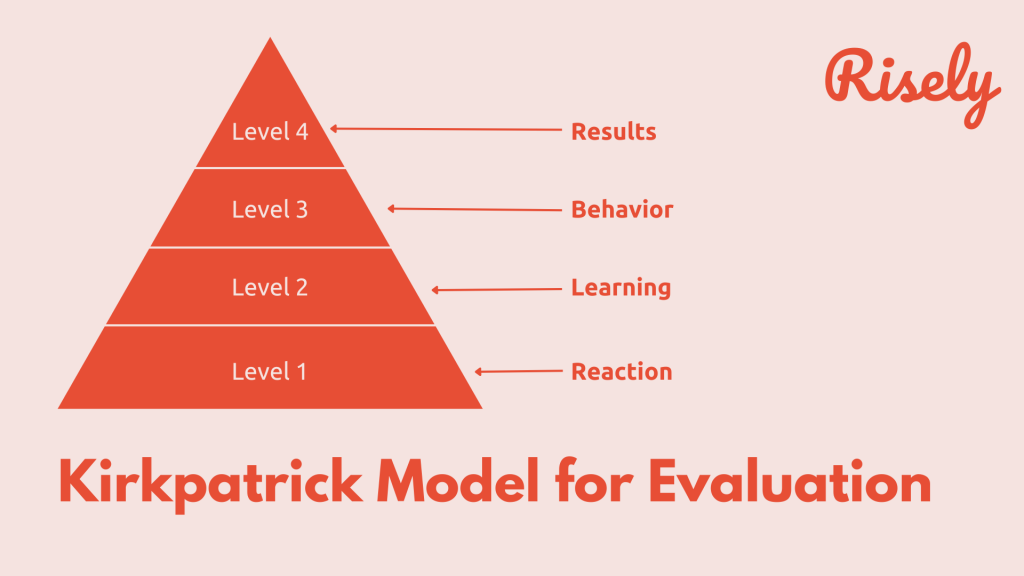Top 5 Learning Evaluation Models for L&D
Are you a manager who is responsible for employee training? Do you want to know how effective your training programs are? If so, then you need to evaluate your training programs. But where do you start? Many learning evaluation models are available, and choosing the right one can be overwhelming. In this blog post, we will explore the top 5 learning evaluation models managers can use to evaluate their training programs. We will cover everything from the popular Kirkpatrick Model to the lesser-known Brinkerhoff Model. By the end of this post, you will have a clear understanding of each model and be able to choose the one that best suits your needs. So let’s dive in and discover which learning evaluation model is right for you and your team!Understanding Training Evaluation Models
A training evaluation model is a framework or set of criteria used to assess the effectiveness and impact of learning and development. It helps determine whether the ROI of training was positive, if the training objectives were met, if participants gained the desired knowledge and skills, and if the training positively impacted performance and organizational goals. Managers leading learning initiatives need a training evaluation model to ensure that training programs deliver the desired outcomes and provide a return on investment. By evaluating the effectiveness of your training, managers can identify areas for improvement, make informed decisions about future training initiatives, and demonstrate the value of your programs to stakeholders. Various models are available for evaluating training, such as Kirkpatrick’s Four-Level Model, Phillips’ ROI Methodology, and Brinkerhoff’s Success Case Method. Each model has its approach and focuses on different aspects of evaluation. Selecting an appropriate model depends on your specific needs and goals for evaluating your training programs. Check out: The Complete Guide to Training Evaluation Survey (With 20+ Questions)The Kirkpatrick Model Explained
The Kirkpatrick Model of training evaluation is valuable in evaluating a training program’s effectiveness. Evaluating training programs is essential to ensure that it aligns with an organization’s strategic goals and provides value to stakeholders. Learning evaluation models like this help quantify the importance of learning programs, making it easier for subject matter experts to justify investments in L&D.
Pros:
- Comprehensive evaluation: The Kirkpatrick model provides a structured approach to evaluating training at four levels: reaction, learning, behavior, and results. It allows for a more comprehensive assessment of the training’s impact.
- Focus on outcomes: The model emphasizes the importance of measuring the actual outcomes and results of training, such as changes in behavior or performance, rather than just participant satisfaction.
- Flexibility: The model can be adapted to different training programs and contexts, making it widely applicable across industries and organizations.
Cons:
- Complexity: The four-level framework can be complex and time-consuming, especially for smaller organizations with limited resources.
- Difficulty in measuring higher-level outcomes: Evaluating the impact of training on organizational results (Level 4) can be challenging, as multiple factors often contribute to these outcomes.
- Potential bias: The model relies on self-reporting from participants and supervisors, which may introduce bias into the evaluation process.
The CIRO Model and Its Benefits
If you’re looking for a comprehensive approach to evaluating your learning program’s effectiveness, consider using the Learning Evaluation Model, the CIRO model. The CIRO model stands for Context, Input, Reaction, and Outcome. It is a four-level approach to training evaluation that aims to assess the effectiveness of training programs. This valuable tool allows managers to determine how well your program aligns with strategic goals and objectives while identifying improvement areas. The CIRO model delivers various benefits, such as improved accountability and more accurate ROI measurement. Managers can track learner satisfaction metrics effectively while measuring the organization’s impact.- Context: This level focuses on understanding the organizational context in which the training takes place. It involves identifying the organization’s goals, needs, and challenges and aligning the training objectives with those factors.
- Input: The input level involves evaluating the design and delivery of the training program. It includes assessing the quality of instructional materials, trainers’ expertise, and the overall training process.
- Reaction: The reaction level focuses on participants’ feedback and satisfaction with the training. It collects participants’ perceptions, engagement, and overall response to the training experience.
- Outcome: The outcome level measures the impact of the training on individual and organizational performance. It aims to assess how much the training has achieved its intended goals and contributed to tangible results, such as improved knowledge, skills, behavior change, or business outcomes.
Other Interesting Reads
Using the Phillips ROI Model for Training Evaluation
When evaluating the effectiveness of a training program, managers need to consider multiple metrics. The Phillips ROI Model is one such approach that helps measure the return on investment (ROI) by conducting cost-benefit analyses and presenting data-driven results. It’s an effective way to demonstrate the value of learning models and strategies to stakeholders. However, using only this model may not provide a comprehensive view of how successful a training program is in achieving strategic goals. The Phillips ROI Model consists of five levels of evaluation:- Level 1: Reaction and Satisfaction – This level assesses participants’ reactions and satisfaction with the training program. It measures participant feedback, perceived relevance, and overall satisfaction.
- Level 2: Learning – The learning level evaluates the knowledge, skills, and attitudes gained by participants due to the training. It involves assessing the extent to which participants have acquired the intended learning outcomes.
- Level 3: Application and Implementation – At this level, the focus is on evaluating the extent to which participants apply what they learned during the training. It examines whether participants have implemented the new knowledge and skills in their work environment.
- Level 4: Business Impact – The business impact level measures the direct impact of training on key performance indicators (KPIs) and business outcomes. It looks at factors such as productivity, quality, customer satisfaction, revenue, and cost savings that can be attributed to the training program.
- Level 5: ROI – The final level of the model is ROI, which quantifies the financial return on investment of the training program. It compares the monetary benefits gained from the program, such as increased revenue or cost savings, to the costs incurred in delivering the training.
The Brinkerhoff Model: An Alternative Approach
The Brinkerhoff Model offers an alternative approach to evaluating the effectiveness of learning interventions. This model focuses on measuring key performance indicators (KPIs) directly linked to business objectives, making it easier for learners and managers to understand its relevance. By conducting a pre- and post-training assessment, as well as a follow-up evaluation, the model provides a comprehensive view of how training impacts strategic goals and organizational success. Continuous learning and improvement is encouraged by using feedback from stakeholders and making necessary adjustments to the learning program, ensuring that learners receive the best possible experience. Incorporating this model into your learning strategy can result in better results and increased ROI while aligning with your objectives by identification of the success cases using the following steps:- Identify Success Cases: The first step is identifying individuals or groups who have achieved exceptional results or improvements due to the training. These are considered success cases.
- Collect Data: In this stage, data is collected from the success cases and a comparison group of participants who did not achieve the desired outcomes. The data may include performance metrics, qualitative feedback, observations, and other relevant information.
- Analyze Success Factors: The data collected is analyzed to identify the critical success factors contributing to positive outcomes. These factors can include individual characteristics, support systems, job-related factors, and other elements that influence the transfer of learning into improved performance.
- Share Success Stories: The identified success cases and their stories are shared within the organization or with relevant stakeholders. These success stories serve as evidence of the impact of the training and inspire others by showcasing what is possible.
- Identify Improvement Strategies: Based on the success factors identified, strategies and interventions are developed to replicate or enhance the conditions that led to success. These strategies may include modifications to the training program, support system changes, or work environment adjustments.
- Continuous Learning and Improvement: The process is cyclical, encouraging continuous learning and improvement. As new success cases emerge, they are studied, and the findings inform further enhancements to the training program and support systems.
Kaufman’s Model of Learning Evaluation
Kaufman’s Model of Learning Evaluation is designed to evaluate learning programs comprehensively. This model emphasizes data-driven decisions about learning programs while considering multiple stakeholders in the evaluation process. It has six levels of evaluation which range from inputs to societal outcomes. With Kaufman’s Model, managers can evaluate long-term benefits and attain better results by making necessary adjustments to their training program. This system ensures that the organization’s strategic goals are met effectively with specific learning interventions. Furthermore, it encourages continuous improvements by taking feedback from stakeholders and making required adjustments to the L&D program. The model consists of five levels of evaluation, often referred to as the 5 Ps:- Person: This level focuses on evaluating the knowledge, skills, attitudes, and behaviors of individual learners. It assesses the extent to which learners have acquired the intended learning outcomes and how they have applied them in their work or performance.
- Program: The program level evaluates the effectiveness of the learning program itself. It examines the design, delivery, and instructional strategies used in the learning intervention. This level assesses the quality of the training materials, resources, and the overall learning experience.
- Performance: The performance level assesses the impact of learning on job performance. It evaluates whether the learning has improved job performance, increased productivity, and enhanced work outcomes. This level focuses on the application and transfer of learning to the workplace.
- Process: The process level examines the efficiency and effectiveness of the learning process. It assesses the learning program’s instructional methods, delivery modes, and logistical aspects. This level looks at instructional design, delivery time, and resource allocation factors.
- Purpose: The purpose level connects the learning outcomes with the strategic goals and mission of the organization. It evaluates the alignment between the learning program and the organizational objectives. This level assesses the learning initiative’s overall contribution to the organization’s strategic success.
Conclusion
In conclusion, no one-size-fits-all approach to choosing a learning evaluation model exists. It all depends on the nature of your organization, training objectives, and resources available. The key is experimenting with different models and finding the one that works best for you and helps you create an amazing employee experience. An excellent start is by familiarizing yourself with the top 5 models we have discussed – Kirkpatrick, CIRO, Phillips ROI, Brinkerhoff, and Kaufman’s model. Once you find a suitable model for your organization’s needs, you’ll be able to accurately measure your training programs’ effectiveness. For more insights into the world of L&D, stay tuned to our blog!Evaluate training effectively with Risely’s free template!
Grab your copy of Risely’s free training evaluation template and get started.
How do you evaluate learning models?
Evaluating learning models involves assessing their effectiveness, efficiency, and impact on learning outcomes. It can be done through various methods such as conducting surveys, interviews, observations, and analyzing quantitative data. Evaluations may focus on factors like learner satisfaction, knowledge retention, skill development, behavior change, and overall program effectiveness.
What are the 3 evaluation models and methods?
Three commonly used evaluation models and methods are:
– Kirkpatrick’s Model of Evaluation: A widely used model that consists of four levels of evaluation: reaction, learning, behavior, and results.
– Return on Investment (ROI) Evaluation: Assessing the financial return and value generated by a learning program.
– Formative and Summative Evaluation: Formative evaluation involves ongoing feedback and assessment during the learning process, while summative evaluation assesses learning outcomes and final results.
– Kirkpatrick’s Model of Evaluation: A widely used model that consists of four levels of evaluation: reaction, learning, behavior, and results.
– Return on Investment (ROI) Evaluation: Assessing the financial return and value generated by a learning program.
– Formative and Summative Evaluation: Formative evaluation involves ongoing feedback and assessment during the learning process, while summative evaluation assesses learning outcomes and final results.
Other Related Blogs
How to Create a Course with AI: A Guide for L&D Professionals
How to Create a Course with AI: A Guide for L&D Professionals According to a McKinsey survey(1), only 11% of business leaders believe their leadership development initiatives yield meaningful results.…
How to build a Learning and Development Action Plan ft Katie Greenwood
How to build a Learning and Development Action Plan ft Katie Greenwood Does your company’s Learning and Development (L&D) strategy feel like more “guessing” than “winning”? You’re not the only…
Generative AI for Learning and Development: Getting Started
Generative AI for Learning and Development: Getting Started In 2024, organizations spent $401 billion globally on corporate training(1), yet 70% of employees report feeling unprepared for the future of work…
Future proofing a learning strategy for organizations with Inna Horvath
Future Proofing a Learning Strategy for Organizations with Inna Horvath With the advent of AI, everyone’s anticipating changes. L&D leaders in charge of building a learning strategy for organizations are…


